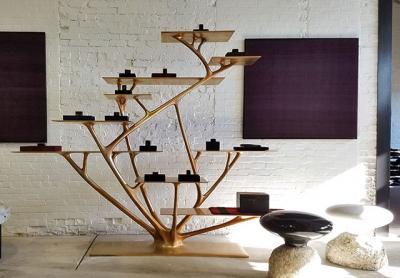Celebrating Darkness in a Season of Lights

Set in an old power station on the outskirts of Southampton’s busy commercial center, Jeff Lincoln’s Art + Design gallery has one of the coolest spaces on the East End. Art viewers are accustomed to the various potato barn galleries that sprout each summer, but this space feels more Meatpacking District than Bridgehampton farm field.
Playing off its high ceilings and industrial interiors, Mr. Lincoln opens his gallery’s garage doors to the air on sunny and warm days and the space is filled with light and objects.
A showcase for both art and design, the gallery is no white box. Instead, Mr. Lincoln sets up seating areas with chairs, tables, lounges, sculptural etageres, benches, stools, and art objects throughout the space, in addition to on the walls. He demonstrates how to live with not only restrained midcentury modern, but the more over-the-top practitioners of design.
The gallery’s fall and winter exhibition, “Heart of Darkness,” features design from the Haas Brothers, John Eric Byers, Wendell Castle, Anna Karlin, Thaddeus Wolfe, and Jeff Zimmerman along with art from Thomas Houseago and Conrad de Kwiatkowski.
Although Mr. de Kwiatkowski’s hangings of Aymara weavings dominate the space, Mr. Houseago’s monumental bronzes tend to steal the show. Mr. Kwiatkowski chose to show his collection of textiles with his sculptures to compose a supplemental exhibition for the space. The weavings are made by women from alpaca and lamb’s wool that is died with the blood of insects. The natural dye produces dark hues of purple, black, and blue, making the rectangular panels a study in tonal negative space.
According to Mr. Lincoln, the artist approached his curatorial duties in the spirit of a wunderkammer, also known as a cabinet of curiosities. These anything-goes collections of odd and unique objects from around the world first became prominent in the age of exploration. The hangings are placed throughout the main room. They mingle with the small basalt sculptures that are carved and polished to bring out their own natural patterns and design qualities. Their smooth surface and natural beauty are enticing.
Mr. Houseago plays with the duality of abstraction and figuration, fine and primitive, suggesting that his monumental bronze sculptures are figures and heads but not doing too much to refine that vision. His “Head (Black Hill I)” from 2010 contains overt or subtle references to Darth Vader, ancient helmets, the monumental head of Constantine in Rome, and all of Picasso’s nods to the tribal and the classical.
Although “Yet to Be Titled (Peeking Figure)” predates it by several years, it seems to have a lot in common with the monster in the Netflix series “Stranger Things” as well as Umberto Boccioni’s “Unique Forms of Continuity in Space.”
Fuzzy creatures, anthropomorphic tables and chairs, pod-like lighting fixtures, prickly vases, and bean-shaped lounges are part of the Haas Brothers’ alternative universe and are placed throughout the space. They add a bit of sci-fi capriciousness to the already eclectic surroundings.
Mr. Zimmerman has a mix of very precisely made light sculptures and molded mirrored glass vessels that look like shiny mistakes, which often have crystals embedded in their hallows. One of these objects, a perfectly formed globular shape akin to a raspberry, stands out in the otherwise imperfect field.
Sometimes it becomes difficult to know which objects are in the show and which are not, but it allows a personal interpretation of what in the space projects darkness and what implies light.
The exhibition will be on view through March 31.
